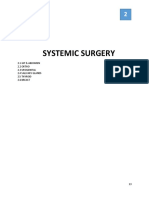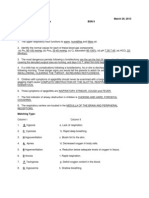Acute Asthma Exacerbation
Acute Asthma Exacerbation
Uploaded by
Roa Al-SajjanCopyright:
Available Formats
Acute Asthma Exacerbation
Acute Asthma Exacerbation
Uploaded by
Roa Al-SajjanOriginal Description:
Copyright
Available Formats
Share this document
Did you find this document useful?
Is this content inappropriate?
Copyright:
Available Formats
Acute Asthma Exacerbation
Acute Asthma Exacerbation
Uploaded by
Roa Al-SajjanCopyright:
Available Formats
Acute Asthma Exacerbation
First... Wash hands Introduce yourself Take permission Ensure privacy
Immediate
1. ABCs a. Airway: is patient able to talk? If not: head-tilt, chin-lift or jaw thrust +/- adjunct airway if unconscious b. Breathing: RR & O2 saturation i. Supplemental oxygen ii. Give bronchodilator (salbutamol; Ventolin) c. Circulation: i. Pulse, BP ii. IV line, keep open with saline and take blood sample CBC, U&E, blood culture d. Level of consciousness
History & Examination
History
HPI: 1. Dyspnea a. Duration b. Onset (triggers) c. Progression d. Severity (grade it) e. Associated: fever, cough, sputum (color, amount), hemoptysis, wheezing, hyperventilation, hoarseness, chest pain 2. Asthma: a. Duration of asthma b. Follow-up c. Hospitalization d. ICU admission (previous intubation) e. Inhaler refills f. Attacks per month g. Night symptoms h. Current medications (corticosteroids, oxygen etc) & compliance 3. Risk factors/Triggers: recent URTI, allergies, smoking, exercise, aspirin, occupational 4. Other: pregnancy
Examination
1. Vital signs: tachycardia, tachypnea, fever? severe: tachycardia >130, pulsus paradoxus 2. General appearance: drowsiness, cyanosis, respiratory distress (use of accessory muscles), inability to speak 3. Chest examination:
a. Inspection: hyperinflation b. Auscultation: biphasic wheezes, severe: silent chest
Investigations
1. Blood: a. CBC: WBC b. U&E 2. ABGs: should be hyperventilation picture (respiratory alkalosis), if acidosis = pending respiratory failure 3. CXR: determine extent of infection if present, exclude pneumothorax 4. PEFR: prolonged; peak flow, FEV1 5. Blood & sputum cultures
Management
1. 2. 3. 4. 5. 6. 7. Admit 1st line: Ventolin (albuterol) Atrovent (ipratropium) 2nd line: Systemic steroids (# in pregnancy) 3rd line: theophylline (cardiac toxicity), magnesium sulphate Antibiotics (if infection suspected) If no improvement: consider ICU admission & intubation
Things You Must Know
1. Classifying severity: 33, 92 CHEST a. Life-threatening: i. PEFR <33% of predicted ii. O2 saturation <92% iii. Cyanosis iv. Hypotension v. Exhaustion vi. Silent chest vii. Tachycardia b. Severe: i. PEFR <50% ii. RR >25 iii. PR >110 c. Moderate: PEFR <75% d. Mild: PEFR >75%
History, P/E (HR, RR, O2 sat, use of accessory muscles, auscultation), tests (PEF, ABGs) 1) Supplemental oxygen (until O2 sat >90%) 2) Inhaled B-agonist for 1 hour 3) Systemic steroids (if no response, on oral steroids or very severe)
Initial Assessment
Initial Treatmant
P/E, O2 saturation, PEF
Reassess in 1 hour
Moderate episode: -Moderate symptoms, PEF 60-80%
Severe episode: -Severe symptoms at rest, PEF <60% -Hx of risk factors for near fatal asthma -No improvement with initial Rx
Continue above treatment for 1-3 hrs
-Oxygen, inhaled B-agonist, systemic steroids -IV magnesium sulphate
Reassess after 1-2 hours
Good response: - Sustained response - Normal P/E - PEF >70%, O2 Sat >90%
Incomplete response: - Risk factors - Mild-moderate signs - PEF <60% - O2 sat not
Poor response: - Risk factors - Severe symptoms - PEF <30% - PO2 <65, PCO2 >45
Discharge
Admit & monitor
Admit to ICU & consider mechanical ventilation
You might also like
- Surgery Blue QuestionsDocument25 pagesSurgery Blue QuestionsJamie ElmawiehNo ratings yet
- Ent MCQDocument9 pagesEnt MCQMuhammad Bilal69% (13)
- S3 Engine IntroductionDocument89 pagesS3 Engine IntroductionManuel Lupo Butron100% (4)
- PallorDocument16 pagesPallorManal AlQuaimi100% (1)
- Pediatrics ApmcDocument13 pagesPediatrics ApmcHannah Lei100% (1)
- Rheum and Renal Long CasesDocument6 pagesRheum and Renal Long CasesNadia SalwaniNo ratings yet
- Neonatal Case Presentation 2Document6 pagesNeonatal Case Presentation 2Rabi SyedNo ratings yet
- Pediatrics CLIPP From QuizletDocument9 pagesPediatrics CLIPP From QuizletJoe ConeNo ratings yet
- Systemic Surgery NuggetsDocument17 pagesSystemic Surgery NuggetsAhmad UsmanNo ratings yet
- Source: 20 Harrison's Principles of Internal Medicine: Nephrolithiasis/Kidney Stone DiseaseDocument8 pagesSource: 20 Harrison's Principles of Internal Medicine: Nephrolithiasis/Kidney Stone DiseaseMartin ClydeNo ratings yet
- Brown Sequard SyndromeDocument4 pagesBrown Sequard SyndromeTănase Anca100% (1)
- Community MedicineDocument77 pagesCommunity MedicineSharon DanielNo ratings yet
- PBL PgamboaDocument6 pagesPBL PgamboaLeanne Princess GamboaNo ratings yet
- Decipher Final Year Updates-1Document10 pagesDecipher Final Year Updates-1Dr NnuNo ratings yet
- Last Hour Review 2020 by Mci Gurukul DR Bhuoendra Armaan Chourasiya PDFDocument49 pagesLast Hour Review 2020 by Mci Gurukul DR Bhuoendra Armaan Chourasiya PDFadiNo ratings yet
- Community-Acquired Pneumoniaandhospital-Acquiredpneumonia: Charles W. Lanks,, Ali I. Musani,, David W. HsiaDocument15 pagesCommunity-Acquired Pneumoniaandhospital-Acquiredpneumonia: Charles W. Lanks,, Ali I. Musani,, David W. HsiaMajo EscobarNo ratings yet
- Case Write UpsDocument4 pagesCase Write UpsMuhammad AzmanNo ratings yet
- Osce Pune Mock Osce 2012Document53 pagesOsce Pune Mock Osce 2012SALAMANDER MUGIWARANo ratings yet
- Acute Infectious Diarrheal Diseases and Bacterial Food PoisoningDocument32 pagesAcute Infectious Diarrheal Diseases and Bacterial Food PoisoningVenkatesh GarikapatiNo ratings yet
- Acute Post-Streptococcal GlomerulonephritisDocument27 pagesAcute Post-Streptococcal GlomerulonephritisAlokh Saha RajNo ratings yet
- Must Know in PleDocument62 pagesMust Know in PleAria Jean MostajoNo ratings yet
- Acute AppendicitisDocument17 pagesAcute AppendicitisMukhtar Khan0% (1)
- Practice Essentials: Essential Update: Chemotherapy Following Radiation May Improve Survival in Low-Grade GliomasDocument19 pagesPractice Essentials: Essential Update: Chemotherapy Following Radiation May Improve Survival in Low-Grade GliomasFika Khulma SofiaNo ratings yet
- Special Senses ReportDocument3 pagesSpecial Senses ReportLeanne Cubar100% (1)
- Imle A 03 03 2015Document82 pagesImle A 03 03 2015Moataz TrabehNo ratings yet
- Medscape Hypovolemic ShockDocument14 pagesMedscape Hypovolemic ShockSarah Ovinitha100% (1)
- MED - Finals 1.5 - Asthma PDFDocument12 pagesMED - Finals 1.5 - Asthma PDFYestin Reece Corpus ArcegaNo ratings yet
- GynecologyDocument3 pagesGynecologyShafaque IrfanNo ratings yet
- Diseases of The CvsDocument24 pagesDiseases of The CvsHussein Al SaediNo ratings yet
- Mcqmeq Osce SurgeryDocument71 pagesMcqmeq Osce SurgeryAshbirZammeriNo ratings yet
- Murmur EvaluationDocument4 pagesMurmur EvaluationManjunath GeminiNo ratings yet
- Clinical ExaminationDocument11 pagesClinical ExaminationMavra zNo ratings yet
- Examining A Short Stature ChildDocument7 pagesExamining A Short Stature ChildKhirren RaoNo ratings yet
- Sterloie Inn MCN AssignmentDocument15 pagesSterloie Inn MCN AssignmentIan Mizzel A. DulfinaNo ratings yet
- Neonatal Examination: 2016 EditionDocument18 pagesNeonatal Examination: 2016 EditionDoha100% (1)
- Pediatrics MALNUTRITION - Dra. Garcia's Lecture: Primum Non NocereDocument8 pagesPediatrics MALNUTRITION - Dra. Garcia's Lecture: Primum Non Nocerekrish100% (1)
- CVS Mini CEX 2Document3 pagesCVS Mini CEX 2Daniel LimNo ratings yet
- TB in ChildrenDocument26 pagesTB in ChildrenReagan PatriarcaNo ratings yet
- AAA - Nelsons 20th Summary Part 1Document79 pagesAAA - Nelsons 20th Summary Part 1Jessica MarianoNo ratings yet
- Triads in MedicineDocument4 pagesTriads in MedicineÐr SalmaNo ratings yet
- FMGE December 4th 2020Document75 pagesFMGE December 4th 2020shimailNo ratings yet
- Pedia ReviewDocument22 pagesPedia ReviewDebbie LanceroNo ratings yet
- Emergency Evaluation of The Child With Acute Abdominal Pain - UpToDateDocument47 pagesEmergency Evaluation of The Child With Acute Abdominal Pain - UpToDateლელა ნიშნიანიძეNo ratings yet
- Diabetic Keto AcidosisDocument31 pagesDiabetic Keto AcidosisIrum QureshiNo ratings yet
- Medical History Outline-2020Document9 pagesMedical History Outline-2020sumiti_kumarNo ratings yet
- Upper and Lower GI Bleeding Differential DiagnosesDocument3 pagesUpper and Lower GI Bleeding Differential DiagnosesKEn PilapilNo ratings yet
- ORL Interns NotesDocument15 pagesORL Interns NotesSandy Chiong MaganitoNo ratings yet
- 2 Approach To The Neuro Exam Feb 2011Document35 pages2 Approach To The Neuro Exam Feb 2011suaqaziNo ratings yet
- Diagnostic Approach To The Adult With Jaundice or Asymptomatic Hyperbilirubinemia PDFDocument14 pagesDiagnostic Approach To The Adult With Jaundice or Asymptomatic Hyperbilirubinemia PDFSurat Saengjinda100% (1)
- Diarrhea: Acute, Sub Acute, & Chronic: - ! DefinitionDocument7 pagesDiarrhea: Acute, Sub Acute, & Chronic: - ! DefinitionWen Jie LauNo ratings yet
- Krok 2 Medicine (EN) Attempt Review 1Document52 pagesKrok 2 Medicine (EN) Attempt Review 1IS ZDNo ratings yet
- Grace Medicial Reviewer Delivery 1233Document3 pagesGrace Medicial Reviewer Delivery 1233Jacob SamsonNo ratings yet
- Physio Ob ReviewDocument368 pagesPhysio Ob ReviewMark LopezNo ratings yet
- Case Study 5 Year Boy With CoughDocument3 pagesCase Study 5 Year Boy With CoughAryl Eduarte100% (1)
- MCQ Year 3,26th July (Omega 7)Document28 pagesMCQ Year 3,26th July (Omega 7)Ammal Dzulfiqar Ismail100% (1)
- OSCE Qs Internal MedicineDocument29 pagesOSCE Qs Internal MedicineRancesh Famo0% (1)
- Question Bank For Mbbs Pediatrics: Long Essay - 20 MarksDocument17 pagesQuestion Bank For Mbbs Pediatrics: Long Essay - 20 MarkspolluNo ratings yet
- Problem-based Approach to Gastroenterology and HepatologyFrom EverandProblem-based Approach to Gastroenterology and HepatologyJohn N. PlevrisNo ratings yet
- Ventricular Septal Defect, A Simple Guide To The Condition, Treatment And Related ConditionsFrom EverandVentricular Septal Defect, A Simple Guide To The Condition, Treatment And Related ConditionsNo ratings yet
- Cyanosis, A Simple Guide To The Condition, Diagnosis, Treatment And Related ConditionsFrom EverandCyanosis, A Simple Guide To The Condition, Diagnosis, Treatment And Related ConditionsRating: 5 out of 5 stars5/5 (1)
- Paeds Revisional SummaryDocument48 pagesPaeds Revisional SummaryJujhar BoparaiNo ratings yet
- Anesthesia & Critical CareDocument103 pagesAnesthesia & Critical CareShawshank 07No ratings yet
- Rule For Pronunciation of Ed, IngDocument8 pagesRule For Pronunciation of Ed, IngMartin AlberaNo ratings yet
- Lesson 4Document18 pagesLesson 4Karl Vincent NonogNo ratings yet
- 26 Scheme For Reimbursement of Mobile Phone & Digital ServicesDocument3 pages26 Scheme For Reimbursement of Mobile Phone & Digital Servicesmurali krishnaNo ratings yet
- Assam) .: Recent Passport Size Attested Photograph of The ApplicantDocument1 pageAssam) .: Recent Passport Size Attested Photograph of The Applicantdata manageNo ratings yet
- Environmental Impacts of TourismDocument9 pagesEnvironmental Impacts of TourismSteven MayoNo ratings yet
- Knjiga 3 - Nacrt Plana Jul 2018Document216 pagesKnjiga 3 - Nacrt Plana Jul 2018Васко ПоповићNo ratings yet
- BBIT Programme Document - April 08, 2021Document158 pagesBBIT Programme Document - April 08, 2021Kenneth MwangoNo ratings yet
- P. W. Serruys - Myval OctacorDocument23 pagesP. W. Serruys - Myval OctacorNeison DuarteNo ratings yet
- Cad 3d in IsraelDocument22 pagesCad 3d in IsraelMihai Madalin SuicaNo ratings yet
- BH-7 Inspector'S Test W/On-Off Unit With Brass Sight Class: ASTM B16 C36000Document1 pageBH-7 Inspector'S Test W/On-Off Unit With Brass Sight Class: ASTM B16 C36000Dhimas IriantoNo ratings yet
- Guide 1 - Bon VoyageDocument8 pagesGuide 1 - Bon VoyageYenniNiñoNo ratings yet
- AutoCAD Electrical JIC Admin Course Syllabus SampleDocument3 pagesAutoCAD Electrical JIC Admin Course Syllabus Samplefadapow4uNo ratings yet
- Embedded Systems: Department of Electrical & Computer Engineering (College of Engineering) Wolaita Sodo UniversityDocument4 pagesEmbedded Systems: Department of Electrical & Computer Engineering (College of Engineering) Wolaita Sodo UniversityyishakNo ratings yet
- Practical Research 2 Summative Test (Module 7,8 9)Document2 pagesPractical Research 2 Summative Test (Module 7,8 9)REYMOND LABOR JR.No ratings yet
- Digital CitizenshipDocument10 pagesDigital Citizenshipapi-564465449No ratings yet
- Africa Grant Funding: Any African NationalDocument2 pagesAfrica Grant Funding: Any African NationalFampau CoulibalyNo ratings yet
- Matlab Assignment-2Document2 pagesMatlab Assignment-2ravindrachoudhary7008No ratings yet
- Indiana University - KelleyDocument6 pagesIndiana University - KelleyMichaelNo ratings yet
- Unit - 2 Clocks and CalendarsDocument3 pagesUnit - 2 Clocks and CalendarsVigneshwaraNo ratings yet
- The Impact of Digitalisation On The Access To Transport Services: A Literature ReviewDocument74 pagesThe Impact of Digitalisation On The Access To Transport Services: A Literature ReviewtzipelNo ratings yet
- Econ 101 A Final PracticeDocument5 pagesEcon 101 A Final PracticeateiskaNo ratings yet
- PROS 6 ACTION PLAN To ADDRESS GAPS and CHALLENGES in The K 12 IMPLEMENTATIONDocument4 pagesPROS 6 ACTION PLAN To ADDRESS GAPS and CHALLENGES in The K 12 IMPLEMENTATIONJAY LAYNONo ratings yet
- Africa 2030Document113 pagesAfrica 2030diana nistoranNo ratings yet
- On Properties of Operation On IntegersDocument15 pagesOn Properties of Operation On IntegersRhea Alo67% (3)
- Tanap Lesson LearnedDocument124 pagesTanap Lesson LearnedserdarNo ratings yet
- Study Report: Car Parks - Fires Involving Modern Cars and Stacking SystemsDocument108 pagesStudy Report: Car Parks - Fires Involving Modern Cars and Stacking SystemsBerkan KayadanNo ratings yet
- Airvac Operations ManualDocument12 pagesAirvac Operations ManualArbortoolsNo ratings yet
- Astm A770 PDFDocument5 pagesAstm A770 PDFCristian OtivoNo ratings yet

























































































